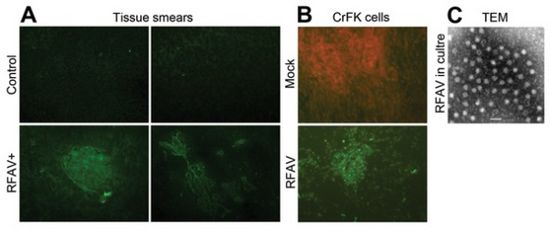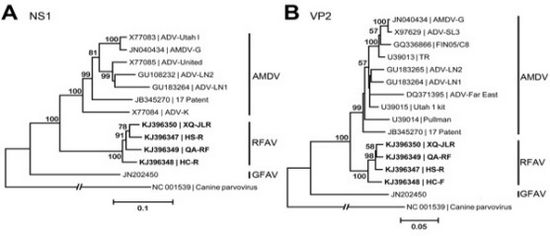分享到
Findings of a Novel Amdoparvovirus Infecting Farmed Raccoon Dogs and Arctic Foxes
Researchers discovered a new amdoparvovirus, named raccoon dog and fox amdoparvovirus (RFAV) from farmed raccoon dogs(Nyctereutes procyonoides) and arctic foxes(Vulpes lagopus) in China. Phylogenetic analyses showed that RFAV belongs to a new viral species within the genus Amdoparvovirus of the family Parvoviridae, which is distinct from Aleutian mink disease virus. Furthermore, Dr. Shao isolated a RFAV strain from a sick animal in Crandell feline kidney cell culture. The evidences of the detection, identification, and isolation of RFAV confirmed that raccoon dogs are naturally susceptible to RFAV infection, and RFAV is most likely the etiologic agent of the sick raccoon dogs causing Aleutian mink disease-like symptoms. The findings update the knowledge to the genus Amdopavovirus. The isolated RFAV strain XQ-JLR is rare material, which facilitates comparative studies of genetic function and immunology between amdoparvovirus species. Additionally, three testing methods were provided to detect RFAV infection. The study was published on Emerging Infectious Diseases Journal, correspondence authors: Professor Fuhe Yang, Dr. Xiqun Shao. http://dx.doi.org/10.3201/eid2012.140289 .
Amdoparvovirus are members of the autonomous parvoviruses, and belong to the genus Amdoparvovirus, whose name coined from Aleutian mink disease virus. Amdoparvoviruses had two species, Aleutian mink disease virus (AMDV) and gray fox amdovirus (GFAV) before. Natural infection of AMDV mainly occurs within the Mustelidae family. AMDV infection in neonatal mink causes acute interstitial pneumonia with a high mortality; whereas, AMDV infection in adult mink manifests with symptoms of glomerulonephritis, plasmacytosis, hypergammaglobinemia, arteritis, decreased fertility, and spontaneous abortion. Aleutian mink disease affects mink farming worldwide, and has become the most significant threat to mink production in some area. In the early of 1970s, AMDV was confirmed to be the pathogen causing Aleutian mink disease. However, the development of AMDV vaccine has failed so far. Today, there are the rare culturable strains of amdoparvovirus in vitro, and little was known about infection and pathogenicity of amdoparvovirus in other carnivores except for mustelids. During the survey of Aleutian mink disease, Raccoon dog cases were observed with Aleutian mink disease-like symptoms. The similarity of symptoms enlightened the findings.

Figure 1. Detection of amdoparvovirus antigens in sick raccoon dogs and infected cells. (A) Detection of amdoparvovirus antigens in tissues ofsick raccoon dogs.(B,C) Detection of amdoparvovirus antigens and virions in infected CrFK cells.

Figure 2. Phylogenetic analyses of amdoparvoviruses. (A) A phylogenetic tree based on the viral nonstructural protein NS1. (B) A phylogenetic tree based on the major capsid protein VP2.
Amdoparvovirus are members of the autonomous parvoviruses, and belong to the genus Amdoparvovirus, whose name coined from Aleutian mink disease virus. Amdoparvoviruses had two species, Aleutian mink disease virus (AMDV) and gray fox amdovirus (GFAV) before. Natural infection of AMDV mainly occurs within the Mustelidae family. AMDV infection in neonatal mink causes acute interstitial pneumonia with a high mortality; whereas, AMDV infection in adult mink manifests with symptoms of glomerulonephritis, plasmacytosis, hypergammaglobinemia, arteritis, decreased fertility, and spontaneous abortion. Aleutian mink disease affects mink farming worldwide, and has become the most significant threat to mink production in some area. In the early of 1970s, AMDV was confirmed to be the pathogen causing Aleutian mink disease. However, the development of AMDV vaccine has failed so far. Today, there are the rare culturable strains of amdoparvovirus in vitro, and little was known about infection and pathogenicity of amdoparvovirus in other carnivores except for mustelids. During the survey of Aleutian mink disease, Raccoon dog cases were observed with Aleutian mink disease-like symptoms. The similarity of symptoms enlightened the findings.

Figure 1. Detection of amdoparvovirus antigens in sick raccoon dogs and infected cells. (A) Detection of amdoparvovirus antigens in tissues ofsick raccoon dogs.(B,C) Detection of amdoparvovirus antigens and virions in infected CrFK cells.

Figure 2. Phylogenetic analyses of amdoparvoviruses. (A) A phylogenetic tree based on the viral nonstructural protein NS1. (B) A phylogenetic tree based on the major capsid protein VP2.
The study was supported by the Special Fund for Public Welfare Technology Research of Agricultural Industry (200903014) and Domesticated Animal Germplasm Platform (2013) from the National Science and Technology Infrastructure foundation.
tcskyc@126.com
Latest News
-
 Apr 18, 2024Opening Ceremony of the Training Workshop on Wheat Head Scab Resistance Breeding and Pest Control in Africa Held in CAAS
Apr 18, 2024Opening Ceremony of the Training Workshop on Wheat Head Scab Resistance Breeding and Pest Control in Africa Held in CAAS -
 Apr 03, 2024IPPCAAS Co-organized the Training Workshop on Management and Application of Biopesticides in Nepal
Apr 03, 2024IPPCAAS Co-organized the Training Workshop on Management and Application of Biopesticides in Nepal -
 Mar 28, 2024Delegation from the School of Agriculture and Food Science of University College Dublin, Ireland Visit to IAS, CAAS
Mar 28, 2024Delegation from the School of Agriculture and Food Science of University College Dublin, Ireland Visit to IAS, CAAS -
 Mar 25, 2024Director of World Food Prize Foundation visited GSCAAS
Mar 25, 2024Director of World Food Prize Foundation visited GSCAAS -
 Mar 20, 2024Institute of Crop Sciences (ICS) and Syngenta Group Global Seeds Advance Collaborative Research in the Seed Industry
Mar 20, 2024Institute of Crop Sciences (ICS) and Syngenta Group Global Seeds Advance Collaborative Research in the Seed Industry
